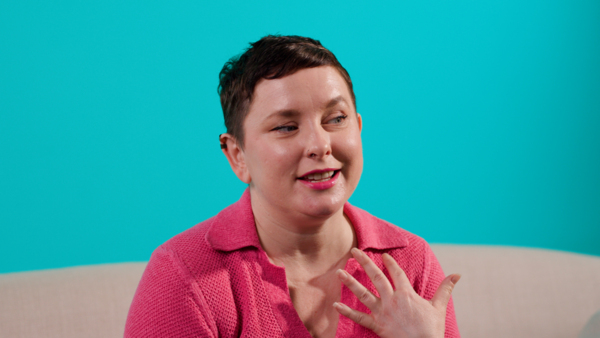Managing your feelings about body changes
It can be hard to adapt to changes in your appearance, but there are different things that can help.
How body image concerns may affect you
Body image concerns may begin before treatment, during treatment or after treatment ends. How much they affect you is different for everyone.
You may feel more self-conscious about your body but find it manageable. Or you might think about your concerns a lot and find that it affects your daily life.
Before treatment, someone from your cancer team will explain what to expect. This might be:
- your cancer doctor
- a specialist nurse
- a radiographer, if you are having radiotherapy
- a pharmacist.
Depending on your treatment, you might also meet with other healthcare professionals who are part of the cancer team. For example, this might be a physiotherapist, dietitian or a speech and language therapist.
Understanding more about treatment side effects and how to manage them can help you feel more prepared and less anxious.
Body image concerns may make you feel:
- less confident
- anxious about people’s reactions to you
- as if you have lost a part of yourself or that you are not the person you used to be
- that you cannot trust your body any more
- worried about your relationship or about starting a new relationship
- less feminine, less masculine or insecure about your gender identity.
You may also feel angry, anxious or sad. These are normal feelings when you are coping with cancer and changes to your body. You may also feel a sense of loss.
Getting support
Talking with people you trust about how you feel can be helpful. This could be your family or friends. Or it could be your cancer doctor, specialist nurse or another healthcare professional from your cancer team. Or you could speak to a trained counsellor.
Talking to another person who has been through something similar can also help. There are different types of support to help you to cope. You can also join our Online Community to talk with people who have been affected by cancer, share your experience, and ask your questions.
Some people may come to appreciate how their bodies have coped with cancer and its treatment. They may see their changes as signs of their survivorship, and value what their body can do more than how it looks.
If you are trans or non-binary
If you are transgender (trans), non-binary or both, you may be coming to terms with physical changes caused by cancer and its treatments. These changes may affect your gender identity and make you feel less like your true self.
UK Cancer and Transition Service (UCATS) provides holistic care and support with both your cancer and gender-affirming care. Your healthcare team can refer you to this service or you can self-refer by filling out a form on its website.
We have more information about cancer and trans and non-binary people.
Getting used to the changes to your body
It takes time to get used to the changes to your body. Sometimes it can take months or even years. Try to allow yourself time for this to happen, and practise being kind to yourself.
If you have a visible body change, such as a stoma, your specialist nurse will show you how to manage it. If you would like to talk about how changes to your body are making you feel, they can help you get the right support.
There are support organisations that can usually put you in touch with someone who has been through a similar experience. Talking to someone who has some understanding of what you are going through can be reassuring for some people. Or you could look for support online.
It can be difficult to look at body changes that are more visible, such as scarring or a stoma. But it can be helpful to look at it as soon as you can, rather than avoiding it. You might consider doing this with someone you trust, your specialist nurse, your cancer doctor, or another healthcare professional in your cancer team. Do not be afraid to ask others for support when you look at it for the first time.
It may help to look at your body change in stages. For example, you could use the following steps:
- Start by looking at the area when it is covered up.
- Move on to looking at it uncovered. You might look at part of it when it is slightly uncovered and gradually look at the whole area.
- Slowly build up to touching the area.
You might find it helpful to use a mirror when you start to look at the change in your body. Try to keep your breathing slow and steady as you do this. If you find it is not getting easier, always ask your cancer doctor or specialist nurse for help.
Anxiety
It is common to feel anxious when you have body image concerns. You may worry about people’s reactions to how you look, or how your relationships may be affected.
Everyone feels anxious at times. But it becomes a problem when it affects your daily life.
You may try to avoid situations or things that make you feel anxious. This may be a relief in the short term. But it can make things more difficult in the long term. Avoiding things means you do not give yourself the chance to find out whether facing your fears is as difficult as you think.
You may find that you are:
- avoiding looking at or dealing with a body change
- not going out or socialising
- avoiding looking in a mirror or wearing certain clothing
- not getting involved in situations that may lead to being intimate with someone
- not doing activities that involve communal changing rooms, such as going to the gym, swimming pool or clothes shopping.
Getting help to understand your fears and working towards taking back control can help reduce them. You may also realise that other people see you in a different and more positive way than you imagined.
There are different resources that give advice on managing anxiety. The NHS has information on stress and anxiety. Anxiety UK also has information to help guide you at home.
Sadness and depression
It is natural to feel sad and low at times when you are coping with cancer and changes to your body. For most people, feelings of sadness lessen or go away. But for some people, a low mood may continue or get worse.
When a low mood continues for weeks or months, or gets worse, you may be experiencing depression.
If you think you might be depressed, talk to your GP or someone from your cancer team. This might be your cancer doctor, specialist nurse or another healthcare professional involved in your care. They can listen and refer you for professional support from a counsellor or psychologist. They may talk to you about also taking prescribed drugs to help treat depression.
What you can to do help you cope with body changes
When you feel ready to start taking control of your situation, there are different approaches that may help.
Setting goals
If you have body image concerns, you may avoid social activities or doing things you enjoy because of your anxiety or low mood. Setting goals can help you overcome these feelings and help you do things that are important to you. Here are some ways to help you decide which goals to set and how to achieve them.
Each goal should be:
- personal – this means it important to you
- realistic – you feel ready or able to deal with it
- achievable – you know you can achieve it
- measurable – you will know how and when you have achieved it
- specific – you have thought about the details that will help you achieve it.
It can be helpful to break your goal into short-term, mid-term and long-term goals.
Problem-solving
Struggling and worrying about problems can make you feel more anxious and stressed. Dealing with them in a structured way can help make them more manageable.
You can do this through a series of steps.
Step 1: Identify the problem as specifically as possible and write it down.
Step 2: Think of possible solutions and write down ones that may help. Think about what has helped you solve problems before. Try to write down all the ideas you can think of at this stage. You might decide to ask someone you trust to help you to think of some examples.
Step 3: Look at each possible solution. Think about the benefits and disadvantages of each idea to help you choose the best one. Choose the solution that seems best to try at this time. You can always go back and try others later.
Step 4: Break the solution down into smaller steps. This will make it easier or more manageable. Plan what you have to do and what support you might need.
Step 5: Try it out and follow the steps at your own pace. If it does not work well, review what happened to help you think about what went wrong. Also remember to think about what went well. If you need to, go back to steps 3 and 4 to choose another solution to try
Dealing with 1 problem successfully can help you overcome bigger problems.
Challenging negative thoughts
Thoughts go through our minds all the time. Often, we are not even aware of it. They can be influenced by our past experiences or imagining things that might happen in the future. They might be based on incorrect assumptions or inaccurate facts.
It is not unusual to have negative thoughts, particularly when you are coping with cancer and changes to your body. But if this becomes a usual way of thinking, it can affect your mood. It can make you feel less confident and more anxious. You may ignore positive things about yourself and believe that all your negative thoughts are true.
Becoming more aware of your thoughts and beliefs can help you discover unhelpful patterns. You can then see the negative effects they have on your feelings and behaviour. This is the basis for cognitive behavioural therapy (CBT).
Recognising unhelpful thoughts can help you challenge them and think in a more positive, balanced way. Try asking yourself the following questions:
- Is what I am thinking definitely right? What is the evidence for and against my thinking? When thinking about evidence, focus on the facts, such as things you can see or have heard.
- Am I jumping to conclusions or getting things out of proportion? Am I seeing the negative and overlooking the positive?
- How might someone else think about this situation? What would I say to a friend in a similar situation?
- Does it help me to think this or say this to myself?
- What would be the effect of thinking about things less negatively?
- What can I do to change my situation? Am I overlooking possible solutions to problems?
There are different unhelpful thinking patterns. We have included some examples of these and how you can change them into more balanced, positive thoughts.
-
Over-generalising
When something has gone wrong in our lives, we may see it as a sign that everything else will now go wrong:
- Negative thought: Everyone will stare at me if I go to the pub.
- Balanced, helpful thinking: Some people may stare, but probably out of curiosity. But I will have my friends with me for support.
-
Taking things personally
When we feel anxious or low, it is easy to make assumptions. For example, you may think everything is related to your appearance or body change:
- Negative thought: I didn’t get the job because of my appearance.
- Balanced, helpful thinking: I didn’t get the job because there was someone better suited to it.
-
Mental filtering
This is when we focus on the negative and ignore the positive.
- Negative thought: The woman in the shop didn’t understand me because my speech is so poor now.
- Balanced, helpful thinking: Although the woman didn’t understand me the first time, she did when I repeated it. So, I can make myself understood.
-
Jumping to conclusions or mind-reading
This is when we think we know what someone else is thinking, without checking that we are right:
- Negative thought: My partner thinks I’m unattractive because of the changes in my body.
- Balanced, helpful thinking: I have many attractive qualities that my partner loves about me.
-
Black and white thinking
This is when we think in extremes of all or nothing, with no grey area in between:
- Negative thought: If I can’t eat a full meal, there is no point in going to a restaurant with my family.
- Balanced, helpful thinking: It would be nice to go out with my family and I can ask for a small portion of food.
When you may need help with body image concerns
If your body image concerns are difficult to cope with, talk to your doctor or nurse. Tell them if you feel anxious or upset a lot of the time, or think you may be depressed. These are normal reactions. But if they do not improve or are overwhelming it is important to get help.
You may need help if you:
- find it hard to look at yourself after treatment
- avoid socialising or doing hobbies or sports you did before because of body changes
- feel very unhappy with your appearance or spend a lot of time ‘fixing’ your appearance
- are having difficulties in your intimate relationship with your partner.
Your doctor can refer you to a counsellor or psychologist. They usually refer you for a type of talking therapy. This can help you understand your feelings better and learn new ways of managing your problems. They may also prescribe medicines to help.
Cognitive behavioural therapy
Cognitive behavioural therapy (CBT) is a talking therapy that helps you understand how to change your thinking. It helps you to identify and challenge unhelpful thinking patterns and behaviours.
You learn to replace unhelpful thoughts with more realistic balanced ones. You develop skills to help you react more positively in situations that make you feel anxious, helpless or depressed. This can help you to cope better and stay calm. It can be a helpful therapy for people with body image concerns.
There are online CBT services approved by the NHS that you can do yourself. CBT and other forms of therapy are also available on the NHS. Check online NHS information services in your area to discover what is available.
But if you are struggling with difficult feelings, it is best to talk to your doctor or nurse for advice. They can refer you to a psychologist or counsellor trained in CBT. A psychologist will talk to you about what might help and set goals with you.
Related pages
Mindfulness
Mindfulness helps you become aware of your thoughts and feelings, without judging them or becoming overwhelmed by them. It uses techniques like meditation, breathing exercises and yoga to help you focus on the present moment.
Mindfulness-based cognitive therapy (MBCT) uses the techniques of mindfulness with CBT. Some hospitals may offer MBCT classes on the NHS.
Booklets and resources
About our information
This information has been written, revised and edited by Macmillan Cancer Support’s Cancer Information Development team. It has been reviewed by expert medical and health professionals and people living with cancer.
-
References
Below is a sample of the sources used in our information about body image and cancer. If you would like more information about the sources we use, please contact us at informationproductionteam@macmillan.org.uk
Asfour L, Montgomery K, Solomon E, Harries M. PS08: The psychological impact of hair loss and the role of psychological interventions. British Journal of Dermatology. 2021; 185(S1): 172–173. Available from: www.doi.org/10.1111/bjd.20356 [accessed September 2023].
Brook I. Early side effects of radiation treatment for head and neck cancer. Cancer/Radiothérapie. 2021; 25(5): 507–513. Available from: www.doi.org/10.1016/j.canrad.2021.02.001 [accessed October 2023].
Elad S, Cheng KKF, Lalla RV, Yarom N, Hong C, Logan RM, et al. MASCC/ISOO clinical practice guidelines for the management of mucositis secondary to cancer therapy. Cancer. 2020; 126(19): 4423–4431. Available from: www.doi.org/10.1002/cncr.33100 [accessed September 2023].
Riopel L. Goal setting in counseling and therapy (incl. examples). PositivePsychology.com. 2019. Available from: www.positivepsychology.com/goal-setting-counseling-therapy [accessed October 2023].
Date reviewed

Our cancer information meets the PIF TICK quality mark.
This means it is easy to use, up-to-date and based on the latest evidence. Learn more about how we produce our information.
The language we use
We want everyone affected by cancer to feel our information is written for them.
We want our information to be as clear as possible. To do this, we try to:
- use plain English
- explain medical words
- use short sentences
- use illustrations to explain text
- structure the information clearly
- make sure important points are clear.
We use gender-inclusive language and talk to our readers as ‘you’ so that everyone feels included. Where clinically necessary we use the terms ‘men’ and ‘women’ or ‘male’ and ‘female’. For example, we do so when talking about parts of the body or mentioning statistics or research about who is affected.
You can read more about how we produce our information here.





